Market failures and (potential) fixes
1/28
There's no tags or description
Looks like no tags are added yet.
Name | Mastery | Learn | Test | Matching | Spaced |
|---|
No study sessions yet.
29 Terms
objectives
Understand the causes and types of market failures and
environmental externalities
• Identify how items such as taxes, subsidies and regulations
influence environmental pollution patterns
• Understand the key principles of effective market-based instrument
Guiding items
-Revisiting supply and demand
• Categorize costs of economic activities
• Types of market failures
• Intervention through taxes and quotas
• Aftermatch: workshop How to assess total costs of production
1. Revisiting Supply and Demand
The traditional Demand-Supply curve:
- Producer willingness to sell (S)
- Consumer willingness to pay (D)
- Equilibrium between private parties
Categorize costs of economic activities
What costs are captured in the supply-demand model for the following goods and services:
• Principal cost (from seller)
• Cost to access market/product/service (from buyer)
What’s missing?
Costs to parties not involved in exchange (i.e. external to the buyer and seller)
- Social and environmental costs of consumptio
Types of market failures
What is a “market failure”?
• Market failure: a situation in which the market-driven allocation of goods and services is not
efficient (not optimal for human welfare)
• There exists another conceivable outcome where an individual may be made better-off without
making someone else worse-off
• Market failures can be the results of ...
• ... the nature or design of a market (interaction of actors needed)
• ... the nature of a good
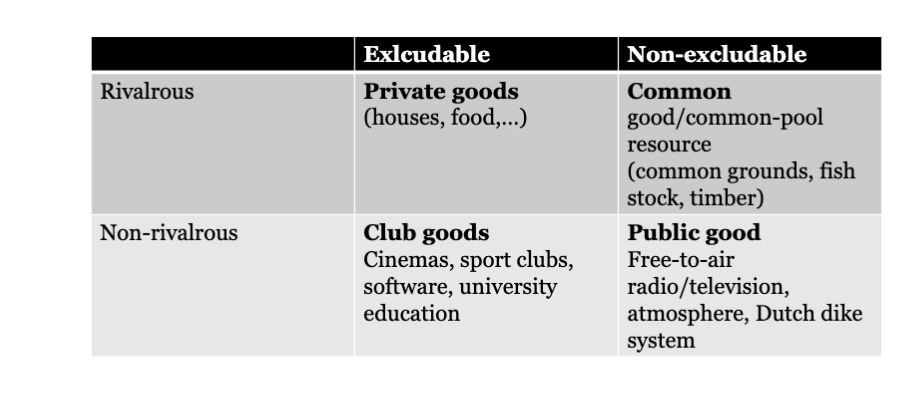
Externality?
Externality:
Markets respond to private costs
Product price does not reflect total, societal costs of production
Societal costs exceed market costs → production exceeds social optimum
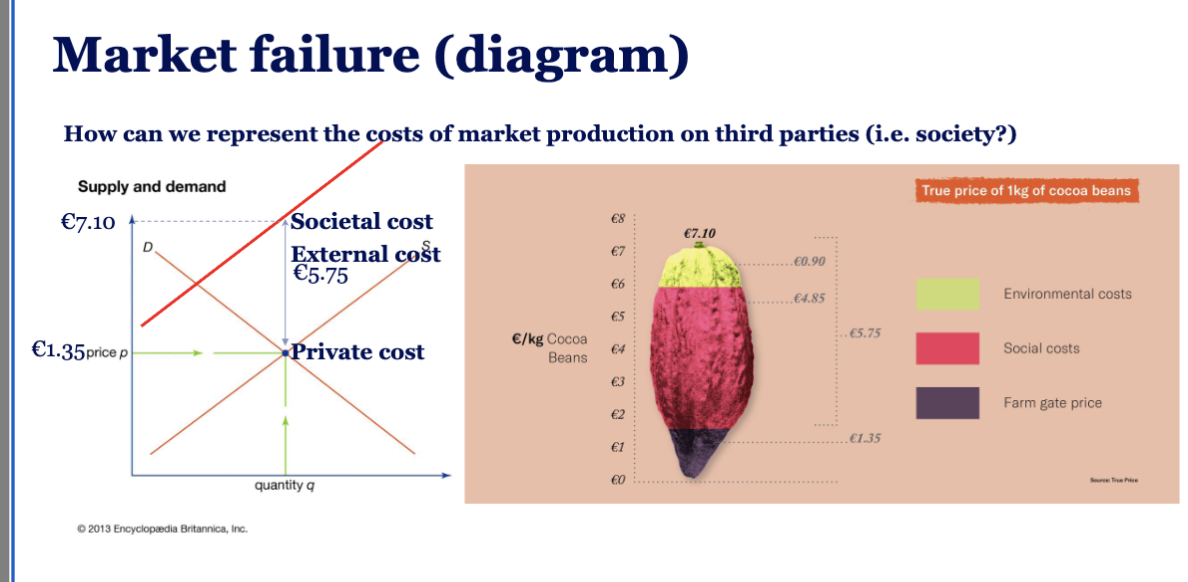
Obvious solution: price the externality!!!
A negative externality implies social cost are above private cost
• Hence: Apply a tax to raise the private marginal cost
• “Internalize the externality” (polluter pays)
• If the tax rate is set at the level equal to the marginal damage, the tax is called a Pigouvian tax
• Vice versa for positive externalities
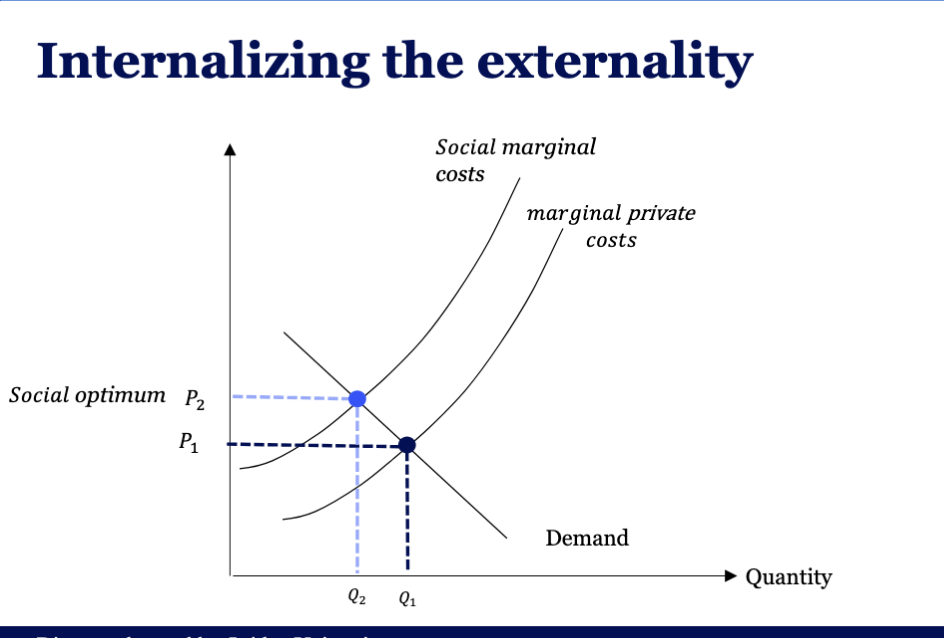
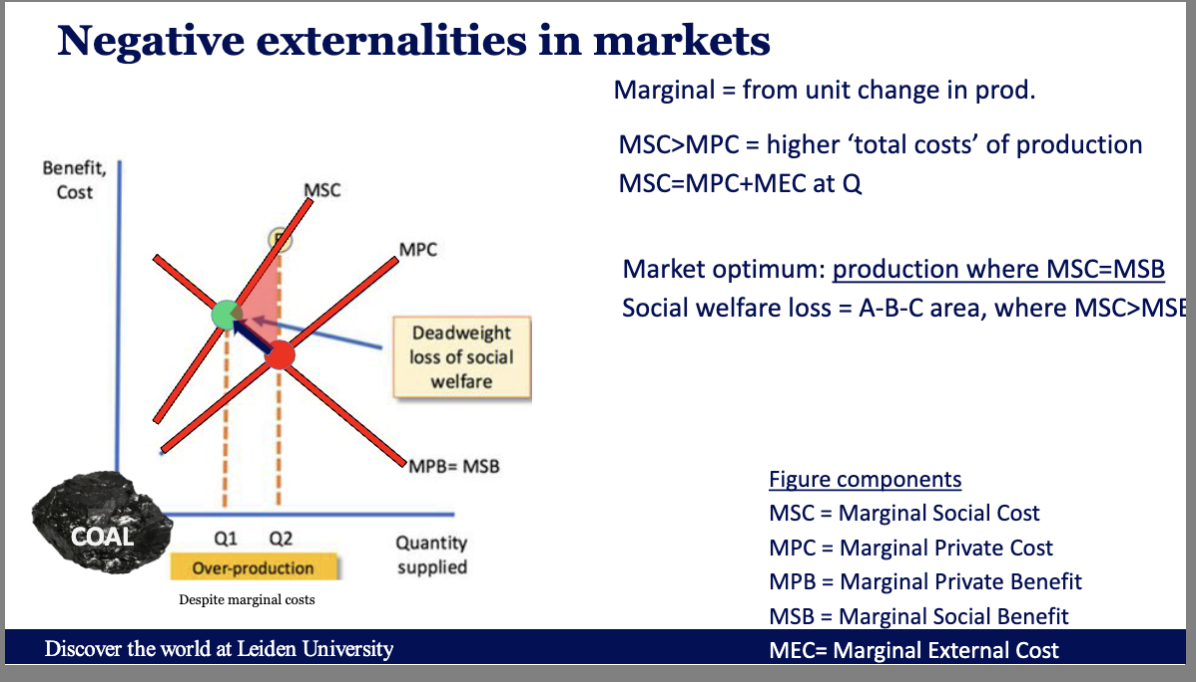
What is climate change?
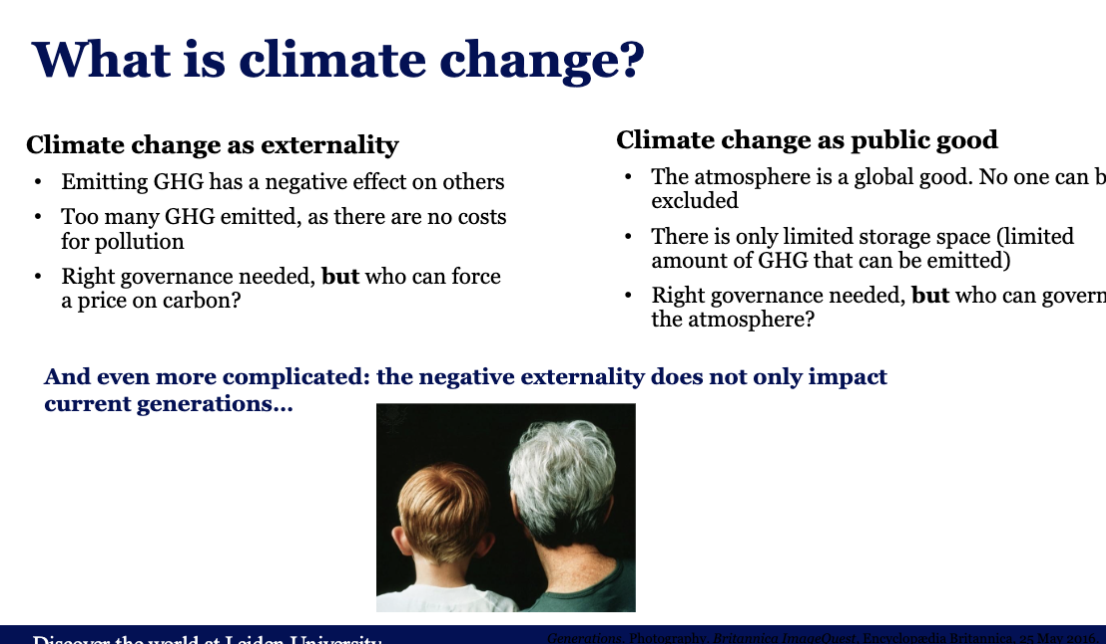
Exam practice question:
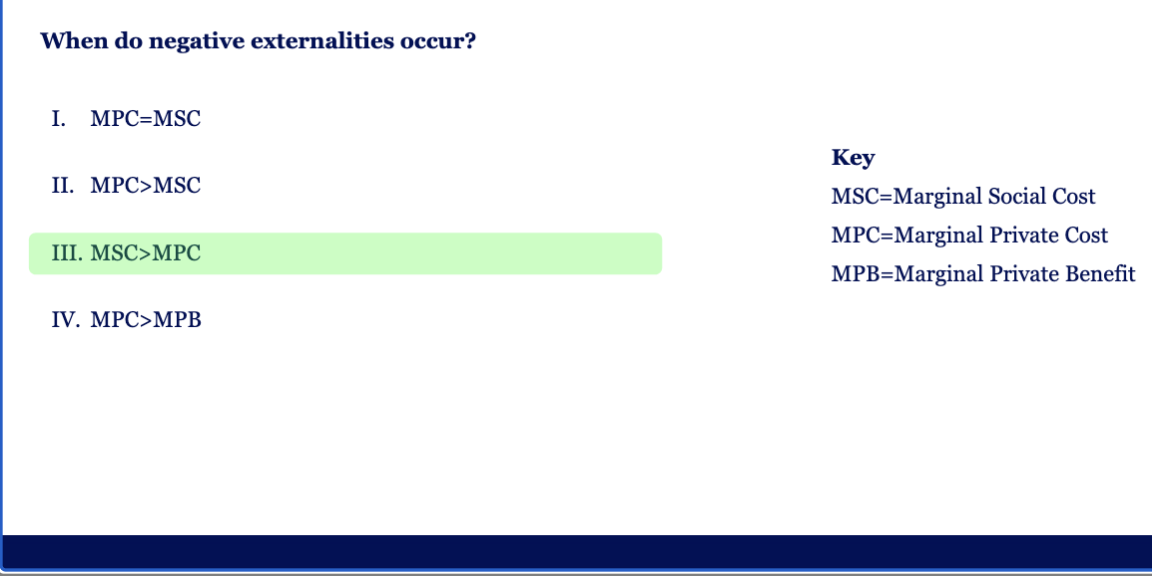
There can be positive externalities
vaccines help other people not to get the diseases
more green spaces are better
= affects other ppl in a good way
Guiding items
Revisiting supply and demand
• Categorize costs of economic activities
• Types of market failures
• Intervention through taxes and quotas
• Aftermatch: workshop How to assess total costs of productions
Intervention through taxes and quotas
Environmental taxes and quota
Defining a tax
A compulsory contribution to state revenue, levied by the government
on workers' income and business profits, or added to the cost of some
goods, services, and transactions. (Oxford English Dictionary)
Defining a quota
Pollution standards in the form of maximum amounts of emmission of
a particular pollutant in the air or the water. They also cover maximum
harvest quotas or minimum forest and natural area covers. (OUP)
Purpose of taxes (and quotas)
• Raising of revenues & control price
• Compensate for damages
• Frequently used to steer behaviour
Examples
- Beard tax (introduced in Russia 1698) to ‘modernize’ the appearance of the society
- Stamp Act 1712 (UK): Tax on newspaper: initially designed to tax the rich. Increasing the circulation of newspaper /made it less accessible for the poor
- Climbing permits in Nepale for high mountains (15,000$ for Mt Everest spring spring season)
- Functionarities in Gongan county, China, Hubei had been orderd to smoke at least 23,000 packs of
(locally produced) cigarettes a yea
Effects of environmental taxes
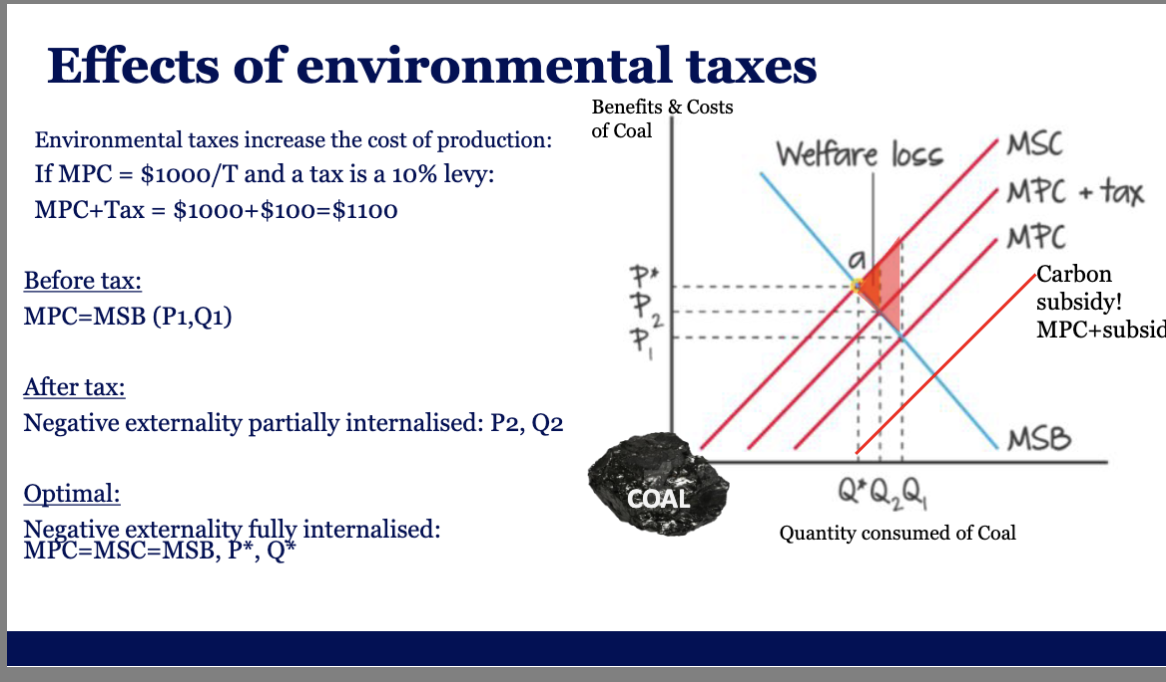
optimal is A
Environmental taxes
- A meat tax could be levied on producers, consumers, or both.
- Taxation level = the social cost of health and environmental impacts
linked to meat consumption and production
- The demand change of consumers depends on the price elasticity of
meat…
- Carbon tax: Ideally identify the virtual carbon content of goods, then
apply the tax equivalent to all damages
Price elasticity of demand (ped
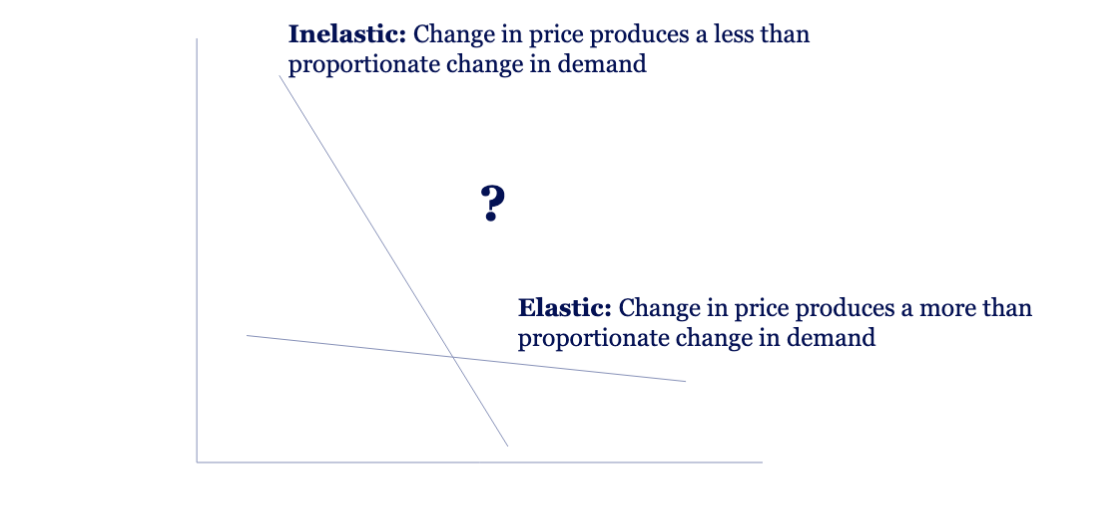
inelastic—> change in price= not rlly a change
elastic—> change in price= a big change
cant substituted easily
Pros and cons of environmental taxes
Pros of environmental taxes
1. *Generates revenue which can be earmarked for green investment
2. Works on the polluter pays principle
3. Easier to implement than a quota to implement on consumption
4. Gives a clear signal, sets economic incentives to adjust
*Hypothecation: dedicated tax revenue to a particular expenditure does not always occur
Cons of environmental taxes
1. Effects on demand depend on the price elasticity of demand
2. Can be regressive, particularly when applied to staple foods/products
3. Requires iteration to be effective (i.e. guesswork on effects)
Effects of environmental quotas
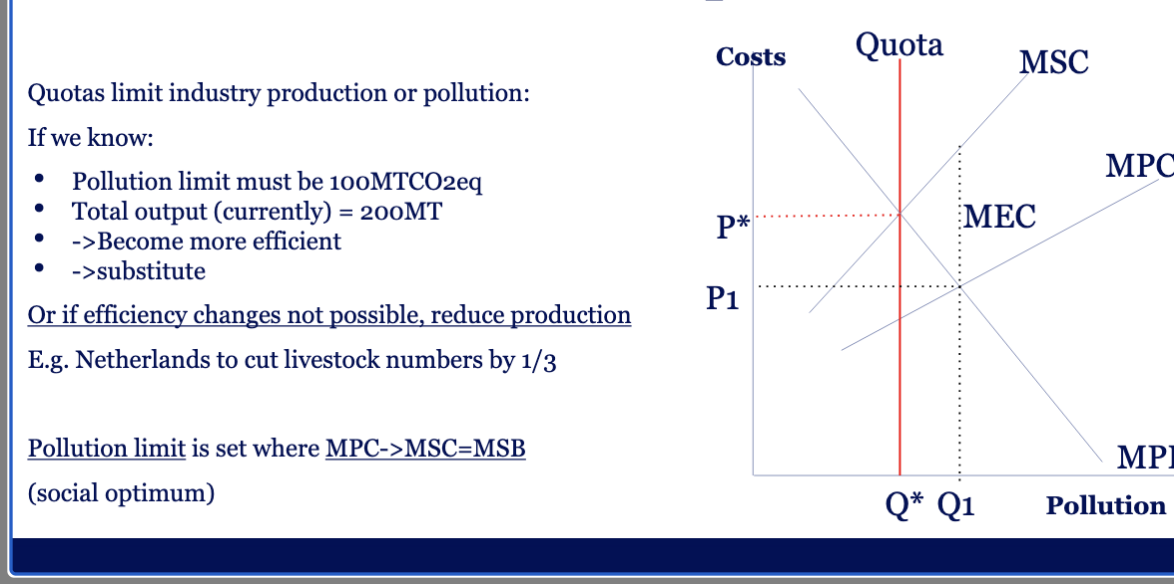
Discover the world at Leiden University
Applied originally to industry then to mobile source
• Mainly focused on air pollutants (187 overall): e.g. particulate matter, ozone,
nitrogen dioxide
• Impact: passenger vehicles 98% cleaner, fuels 90% cleaner
• Estimation: $1:$9 multiplier benefits
Pros and cons of environmental quotas
Pros of environmental quotas
• Immediate effect (good in the case of harmful substances and avoiding tipping
points)
• Informed by science based goals
• Outcome largely expected
Cons of environmental quotas
• Quotas do not incentivise further mitigation
• Disadvantages small and older production facilities
• Fines must ≥ cost of abatement to avoid pollution
• Raises little revenue (only from fines)
Exam practice question:
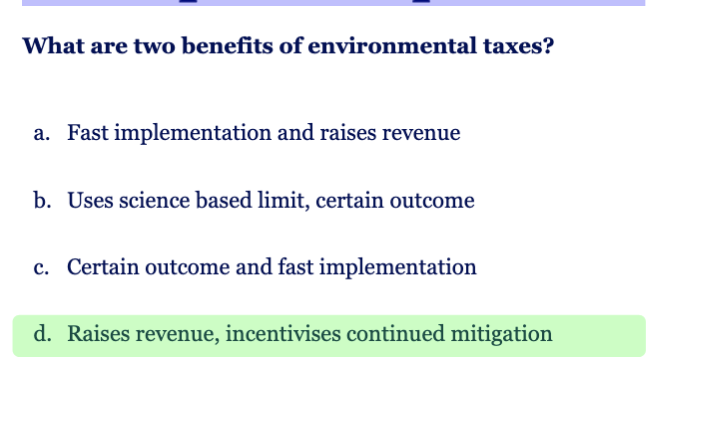
Hybrid solution
Auctioning of quotas
- Limit overall pollution and
- Create a market
- Indicate that quotas will decline over time
• Example: EUETS
Economics in practice!
Market externalities and fixes:
• In addition to negative externalities, positive externalities imply goods which produce a spillover benefit to third parties, such as the pollination service of bees.
• Denmark introduced meat tax
• And a tax on cows (methane taks)
• EU deforestation regulation is a zero quota for traded products linked to overseas deforestation
• Corporate Sustainability Reporting Directive
(CSRD), 2023, requires businesses to report social and environmental impacts
what are the economic costs of the oil spill and design a scheme for compensation of impacted stakeholders
social impacts
economic impacts
env impacts
species die
affects food chain
destroys coastal and marine ecosystems
biodiversity loss
for each impact aim for 2-3 categories
impacted stakeholders
fisherman, consumers, oil producers, companies/ people near the coast
method for monetizing impact
cost of fish
cost to clean up the env impact
loss of business cost
pros and cons limitations of method
loss of business cost
how do we measure it
hard to put monetary value of ecosystem services
pros for price of fish
can the polluter be fully payed or is it also regulated or bailed out by gov
fining the company
pros: maybe they will make more successful equipment that prevents oil spill
con: less economic growth for companies
cost to clean up the env impact
con: only be based on precedent hard to estimate - uncertainty in long term damages
pros: there is an exact cost ; companies invest in an emergency fund
observstions
most costs not formally marketed (demand proxy markets to evaluate)
some are extremely difficult to quantify
costs demand boundary setting (spatially, econ, morally , time horizon)
feedbacks and causality difficult to evaluate
gloal reercussions on energy prices
long term health outcome and intergenerational impacts reputational damage
Cost benefit analysis (CBA)
compares traditional (marketed) costs and benefits of policies
common in early economic policy appraisal
excluded public goods and costs (Externalities)
ex: investing a wind farm involves a large upfront costs (infrastructure , and labor) but reduces long term energy costs
not always counted: carbon saving, effect on local house prices , impacts on nature, shifts jobs
weighted/multi criteria analysis
Economic or non-economic method to compare policy impact(s)
• Impacts given weights in appraisal to reflect their prioritisation
• Reveals trade-offs + helps to achieve desired policy outcomes
CBA = single balance sheet
MCA = multiple balance sheets
Total Economic
Valuation (TEV)
Attempt to capture all costs/benefits into
economic terms
Non-tangible costs are also quantified
Total Economic Valuation (TEV) methods
Contingent Valuation: estimate an economic value for a non-market good/service,
using direct or indirect survey techniques
- Method 1: Willingness to Pay (WTP) survey: How much are you willing to pay for an X
improvement in a good/service (e.g. pandas or rainforests)
- Limitation: no one parts with their money and people want to appear generous
→ overestimated value
- Answer? Indirect questioning: ask what an average person is WTP. People are
more likely to reveal their actual preference
- Method 2: Choice Experiments: elicit the value assigned to an attribute of interest (e.g.
sustainable sourcing or water quality improvement) by surveying consumers on
bundles of attributes and changing them in order to reveal inferred value of the
attribute of interest.
Hedonic pricing: Experimental method for using existing markets to infer price of non-
market goods/services, e.g. green spaces near housing (using house market prices) or
recreation